Hi there friends, followers and fellow film fanatics. It is, without question, well and truly time to examine more of that utterly magical lost art form of the traditional, hand painted and photo-chemically assembled matte shot. I have an epic (truly!) rundown here today, as the continuation of the mammoth tribute piece to
Industrial Light & Magic's matte painting department and the personalities therein.
As with the first part of this extensive overview, I've attempted to cover all of the ILM traditional mattes as best I can, and in chronological order. There are some familiar shots here for sure, but also a number of long forgotten mattes from a mix of genres, all having been a product of the ILM factory. The first film covered here today is one I overlooked in Part One (THE DARK CRYSTAL), so, apologies.
A number of painters continue to be celebrated, as do cameramen and others. Part One included foundation magicians of the matte Harrison Ellenshaw, Alan Maley and Ralph McQuarrie, followed by the next generation of exponents such as Michael Pangrazio, Christopher Evans, Frank Ordaz and Caroleen Green. Part Two carries over some of those storied talents as well as adding in some fresh names such as Sean Joyce, Yusei Uesugi, Richard Van Der Wendt, Paul Swensden and the multi-talented Mark Sullivan. Also, in a couple of film entries I'll point out other non-ILM mattes that were rendered elsewhere by other artists such as Doug Ferris and Charles Stoneham in the UK, as well as veteran Jim Danforth at his Effects Associates fx company. I've endeavoured to be as complete as possible, so if anyone out there spots something that I've missed - be it a matte or film title - let me know.

------------------------------------------------------------------------------------------------------------------
I stumbled, purely by accident, across an excellent podcast website called Filmumentaries, which delves into comprehensive and intelligent guest interviews by creator and host, British podcaster Jamie Benning, with all manner of film industry people, such as ILM and Matte World's Craig Barron and Michael Pangrazio as two examples. Craig's podcast can be found here, while Mike's is here. Highly recommended, and I simply must dig deeper!
---------------------------------------------------------------------------------------------------------------
*** We here at Matte Shot wish to take this opportunity to extend our kind thoughts and utmost support to the sheer strength and resolve of the brave and courageous people, armed forces and legitimate democratic government of the sovereign nation of Ukraine. The frenzy of brutality, mass murder and wholesale destruction - all clearly crimes against humanity - engineered by Putin's fascist, genocidal Russian war machine, upon the innocent Ukrainian population is unforgiveable. The entire 'free' world is on the side of Ukraine, with the Russian invaders international credibility now competely lost due to the actions of their dictator, for generations to come.
All the best.
Pete
--------------------------------------------------------------------------------------------------------------------------
Now, with that important opinion piece off my chest, it's time to begin our journey down the magical matte painted highway...
Enjoy the ride...
***This post, and all 175 previous blogposts known as 'Matte Shot', were originally created by Peter Cook for nzpetesmatteshot, with all content, layout and text originally published at http://nzpetesmatteshot.blogspot.com/

-------------------------------------------------------------------------------------------------------------------------
 |
| In keeping with an intended chronological rundown, I had meant to include THE DARK CRYSTAL (1982) in the previous part of this ILM retrospective, so with oversight corrected, here it now appears. |
 |
| DARK CRYSTAL was an entirely British based production, with visual effects supervised by UK optical veteran Roy Field. Some of the mattes were done at Roy's company Optical Film Effects, in London - and those examples come are shown after I demonstrate the ILM shots. ILM were called and given a total of eight painted mattes to render some while into late production, to further flesh out the broad vistas, and the finished shots were indeed magnificent. This is a Mike Pangrazio matte. |
 |
| Pangrazio at work on above matte at ILM. |
 |
| Another of Mike's mattes from the same sequence. |
 |
| Pangrazio and brush... |
 |
| This beautiful shot was the work of ILM's Christopher Evans. |
 |
| A closer look... |
 |
| Another of Evans' mattes. Unusually, all of the ILM mattes were shot and composited on 4-perf, rather than their standard VistaVision 8-perf. Matte camera operator Craig Barron recalled the assignment as being one of the rare pick-up matte jobs that came into the matte department, and was completely separate from the rest of ILM's operation. |
 |
| This shot is a Mike Pangrazio matte. |
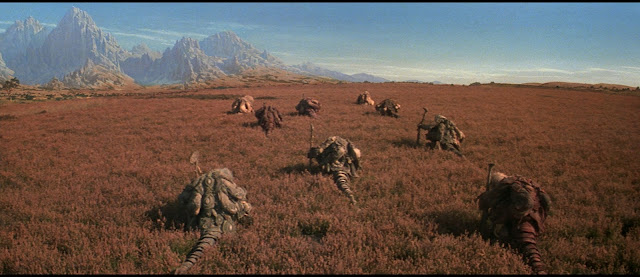 |
| Chris Evans matte shot. |
NON-ILM MATTE EFFECTS SHOTS:
 |
| I'm not completely sure about all of these, but can state that the bottom left frame with the swirling sky was executed at Roy Field's O.F.E in London. Veteran matte artist Doug Ferris first attempted to create the effect as a large glass painting and smoke effects (shown below), but early trials were disappointing. The effects shot was eventually achieved by UK fx man Jon Sorenson as a combined water tank gag. |
.JPG) |
| UK matte artists Charles Stoneham (left) and Doug Ferris (right) at work on mattes. Some fx shots were dropped when the running time was shortened after preview audiences were confused. The 3 mattes here were Stonehams work. |
.JPG) |
| These four mattes were also painted by Charles Stoneham and photographed by Martin Body at Roy Field's Optical Film Effects. |
---------------------------------------------------------------------------------------------------------------------------
 |
| I seem to recall that Ron Howard's COCOON (1985) might have won the best vfx Oscar that year. |
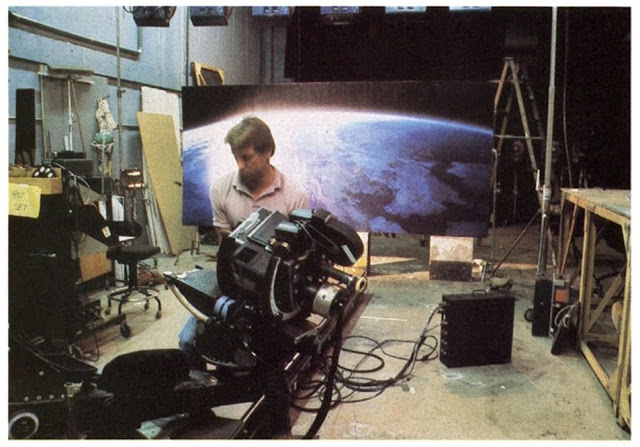 |
| The film featured only a few matte painted shots, though the numerous cel animated optical shots were really impressive. |
 |
| Multi-plane matte art for camera move which opens the show. |
 |
| Kid on set shot against a blue screen, with an extensive Caroleen Green matte painted neighbourhood and moonscape added in. |
 |
| Caroleen Green shown here at work on the above matte art. |
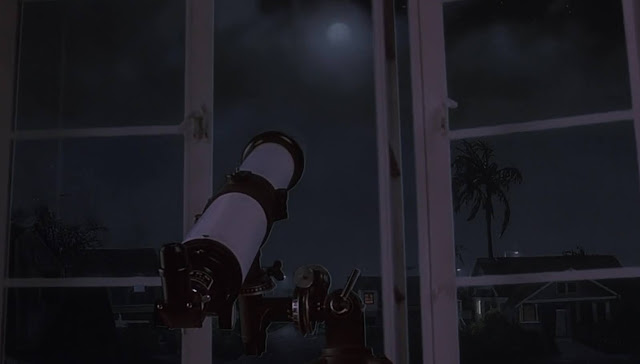 |
| Matted housing sub-division. |
 |
| A closer view of Caroleen's moonscape. |
 |
| Setting up the huge multi-plane glass painted intersteller vista for the dramatic conclusion of COCOON. A total of four 8 foot square glass sheets were required. Matte supervisor Chris Evans used translucent acrylic paint and careful airbrushing. The sheets of glass were mounted parallel to each other, backlit, and shot with a motion control camera move, with the miniature mothership composited in later. |
 |
| Matte painter Caroleen Green shown with large scale artwork and spacecraft miniature in what is likely a paste-up departmental publicity shot. |
 |
| Green armed with airbrush, completes the giant Earth painting as part of the concluding sequence. |
 |
| And this is how the sequence shaped up on screen (also see following frames...) |
 |
| A great little movie, bolstered by the wonderful cast, especially the late, great Brian Dennehy and the always remarkable veteran, Hume Cronyn. |
----------------------------------------------------------------------------------------------------------------------
 |
| Joe Dante's EXPLORERS (1985) was, to a certain extent, entertaining, but, as with many of Joe's flicks, just never knew when to quit! All of the Earthbound stuff was great, but once the alien creatures got in on the act it became tiresome, rather quickly. It does, however, have Dick Miller in it.... always a plus! |
 |
| Around a dozen matte paintings were used in EXPLORERS, with all being night time suburban neighbourhoods and the like. Here is artist Sean Joyce at work on one such view. |
 |
| Sean's painting with miniature home built DIY spacecraft, theThunder Road, doubled in, along with foreground tree elements. |
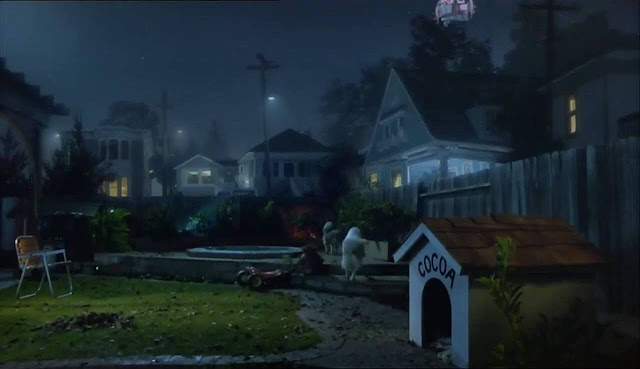 |
| Extensive matte art brings nice ethereal moonlit luminence to the proceedings that actual location first unit work couldn't. |
 |
| More mattes expand the kids environs. The lower left Drive-In sequence was a hoot, with deliberately hokey faux bad sci-fi flick playing, all out of sync, if I recall - much like some 60's Italian space epic! Gets really funny when an actual genuine flying saucer cruises up in front of the screen and buzzes the audience, with one slick guy in his car trying to impress his girlfriend with: "Oh, that's so bad... you can even see all of the matte lines" (if I recall). Best bit in the movie. |
 |
| Sean Joyce adds detail to one of his many mattes... |
 |
| The final shot ... |
 |
| Lining up a substantial foreground miniature set with background matte art. |
 |
| Both Sean Joyce and Michael Pangrazio shared painting duties on EXPLORERS. |
 |
| Presumably window illuminations etc must have been backlit gags, possibly shot a separate pass. |
 |
| The painting used for the above shot, with matte cameraman Craig Barron shown here. |
 |
| A combined large matte painting with added physical 3D relief, a layer of fibrefill clouds strategically arranged on a glass plate, with the Thunder Bay model craft doubled in. |
--------------------------------------------------------------------------------------------------------------------------
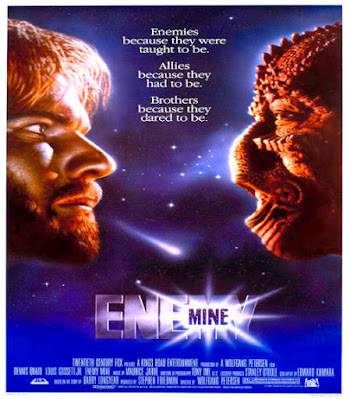 |
| German director Wolfgang Peterson turned out a reasonably interesting sci-fi take on the old Lee Marvin-Toshiro Mifune classic, HELL IN THE PACIFIC, with this space opera, ENEMY MINE (1985). |
 |
| The flick was okay I guess, but made quite watchable with good fx character make up and ILM's excellent visual contibutions. |
 |
| As a visual effects showcase, the film stands up very well, even decades later, and features a great number of beautiful painted mattes. |
 |
| Original footage made by another director was shot in Iceland, but all of that work was jettisoned by the studio due to 'artistic differences' and schedule over-runs. Filming resumed under a new regime and the unit was sent to Lanzarote, in the Canary Islands, where WHEN DINOSAURS RULED THE EARTH had been filmed many years earlier, to excellent effect. |
 |
| Before and after where exotic landscape has been enhanced with painted sky and moons (see below) |
 |
| The same matte shot, though optically flopped for the release version. |
 |
| A Chris Evans matte (see below) |
 |
| Chris Evans works on one of the many mattes for the show (see below), while at upper right is director Wolfgang Peterson, seen here with one of the miniature sets built and shot at Bavaria Studios in Munich, Germany. The troubled production saw all interiors and sets shot in Munich, while second unit and plate photography for alien landscapes were shot in the Canary Islands. Post-production opticals and matte work was all carried out back at ILM. |
 |
| The crashed ship and much artwork... |
 |
| Before and after pre-comp. |
 |
| The final composite of the above frames. |
 |
| I'm not sure if the actors went to Lanzarote, or just the 2nd unit and effects unit camera crews? |
 |
| The matte department had already formulated an overall 'look' and design for the various shots before first unit production was underway with the initial director, though these designs were later altered and reimagined somewhat once the new director took the reigns. |
 |
| German film maker Wolfgang Peterson in ILM's matte studio. |
 |
| I'm not sure, but this might be the same matte shown above, with sky now painted in? |
 |
| Matte cameraman Craig Barron and assistant Wade Childress went to the Canary Islands and shot many 8-perf latent image plates with their VistaVision camera. |
 |
| The meteor shower... probably due to global warming or some such thing... |
 |
| Virtually all of the mattes were executed as original negative composites to maintain maximum quality. The matte department were heavily involved with the planning of proposed mattes from early on in the production, importantly, as the paintings and comps were to be o/neg, so much foresight was required. |
 |
| Miniature, matte art and blue screened actors in Munich. |
 |
| The director was very specific about colour schemes, with those decided upon in conceptual design sketches translate accurately with mattes and composites. |
 |
| A spectacular tilt matte shot. |
 |
| A closer look at the upper part of that same matte. |
 |
| Likewise with the lower portion... |
 |
| Matte cinematographer Craig Barron and chief matte painter Chris Evans were gung-ho about using the latent image original negative technique, to maximise quality, colour matching, subtle soft edged blending and no loss of contrast given the many night time matte shots. |
 |
| This expansive shot lasts on screen for one whole minute and contains various elements. The ocean and intense sun was a live plate filmed in San Francisco, the sky, mountains and much of the crowd were all a matte painting, They filmed some 30 extras in costume and composited them into areas of the painting via front projection. |
.jpg) |
| Amid a grandest of intergalactic vista's, our two actors are doubled in atop the cliff. |
 |
| ILM artist Sean Joyce with his jaw dropping sunset painting. An ardent admirer of master matte painter Albert Whitlock, in an interview Sean stated that this particular matte painting was his own personal tribute to Whitlock. |
 |
| Cameraman Wade Childress arranges Sean's splendid painting for photography, as well as a separate 'burning sun' element to complete the effect. |
 |
| The sun sinks slowly into the west... |
---------------------------------------------------------------------------------------------------------------------
 |
| The 1985 pic YOUNG SHERLOCK HOLMES (called PYRAMID OF FEAR in this part of the world for some inexplicable reason!) was another dazzling fx showcase, resulting in another nomination for the ILM effects boys. |
 |
| Michael Pangrazio adding fine detail to one of just three mattes required for the film. |
 |
| Mike's painting in an original negative matte shot. |
 |
| A lousy image, but it is in full colour. I do try to be as complete as possible with what I have on file. |
 |
| An interesting combination shot, with foreground miniature street and buildings, matte painted city beyond, and live action figures doubled in. Incidentally, the film was a bonanza of VFX, with brilliant stop motion, opticals and the first ever(?) digitally created 'stained glass man', which was a show-stopper. |
 |
| The only other matte painting that I'm aware of was this one - I think the work of Caroleen Green - with additional fx elements added later. I recall Craig Barron explaining this shot to me years ago, and I think he stated that the original live action plate with actors climbing (or sliding?) on pyramid's facade - shot in England - was unusable due to camera motor surge or flicker. The matte department, I recall, had to cel animate the figures in front of the painting. Interestingly, this sort of 'animation' over a painted scene was an old and tried & true technique used by Albert Whitlock on scores of films, and really set a benchmark within the vfx industry. |
---------------------------------------------------------------------------------------------------------------------
 |
| Aside from TV's 70's MUPPET SHOW I could never really get into the Jim Henson kiddie-fantasy films. Probably due to my passion for Dario Argento and DePalma horror and hard-hitting Sidney Lumet type serious police drama. Anyway, LABYRINTH (1986) was a massive hit, so what do I know. |
 |
| Oh, and Jennifer Connelly was an absolute doll (and hey, she even appeared in Argento's blood, corpse and maggot soaked CREEPERS around the same time, so that's something!) |
_2739.jpg) |
| Interestingly, the film was a UK based show, with the effects largely carried out there. I'll demonstrate the British matte shots after the ILM shots. I think Caroleen Green may have painted this one? |
 |
| Some closer detail... |
 |
| Not sure if this matte is the exact same painting or one not used? It may be one of Doug Ferris' mattes from the UK? Note the face of David Bowie clearly woven into the hedgerow, a point that Ferris made a point of mentioning in an interview, and how Henson wanted to merge Bowie's visage into as much of the matte work as possible. |
_3803.jpg) |
| Not sure if this one is ILM, but there is Bowie's face painted into the stonework at right. |
 |
| This shot I can confirm is a Caroleen Green painting, with this frame enlarged from an original unbalanced 35mm trim. |
 |
| The same shot as seen in the BluRay edition. |
NON-ILM MATTE SHOTS:
 |
| Veteran British matte and optical artist Doug Ferris and matte cameraman John Grant supplied a number of shots. According to Grant they did some 14 shots though I could never find that many, so maybe some were dropped in the final edit, or replaced by ILM later? This sequence is Doug's. |
.jpg) |
| The same sequence rendered by Doug Ferris and John Grant. Doug started off in 1961 at Shepperton Studios in England, with the sci-fi classic THE DAY OF THE TRIFFIDS being his first film in which he provided stop-motion miniature cars doubled into a matte painted deserted Paris. |
 |
| Another of Doug's shots. Nice painting and atmosphere but marred by a less than impressive marriage of artwork to live action plate, sadly. |
 |
| Not certain who did these, though I'm sure a fair amount of subtle and well integrated matte art was needed to breath life into these amazing Escher-esque sets. |
_6192.jpg) |
| The sets would have been impossible to construct as a practical environ - a veritable nightmare for architects and carpenters I'd imagine. |
_6123.jpg) |
| Certainly an optical composite joining different partial sets, no doubt blended with subtle matte art. |
_6036.jpg) |
| Fabulous art direction, with this extended matte art and optical fx sequence being the film's highlight. |
-----------------------------------------------------------------------------------------------------------------------
 |
| You can't criticise Pete for not going the whole distance for the sake of this splendid blog-site. I saw this stupid bloody thing back in the 1980's and felt it was utter crap. In spite of those dark memories from decades ago I felt it my duty to take another 'gander' at HOWARD THE DUCK (1986) for the purposes of matte shot evaluation! Still crap, but not quite as bad as I seem to recall, with some moments of amusement amid the many visual effects... and Lea Thompson is still kinda hot. |
 |
| In my part of the world, this film was released with no mention of a fucking duck being the leading character (for good reason!), and was retitled HOWARD - A NEW BREED OF HERO. Audiences spat out their popcorn once it became apparent the 'star' had webbed feet, a bill and feathers!!! Probably demanded their hard earned coin back. Anyway, the top frame is some sort of fx shot, though is part of a very broad pan across the Duck's city. Possibly a full city painting, or at least the night sky? |
 |
| A number of impressive matte shots occur - mostly in the first 10 minutes - with this spectacular 'birds-eye' vantage point of Duckberg(!) |
 |
| Frank Ordaz was supervising matte painter, with Sean Joyce, Richard van der Wendt and the lovely Caroleen Green tasked with much brushwork. |
 |
| I had hoped it were 'duck season', but unfortunately it was 'wabbit season'. Think about it...it's a rather clever joke ;) **(apologies to the late, great Mr Chuck Jones) |
 |
| Spectacular matte art augments an indescribable sequence where 'Howard' is sucked out his home planet straight through to Earth. Who writes this stuff? |
 |
| Many of the galactic shots feature a subtle camera move, sometimes multi-plane. |
 |
| Multi-plane matte work where said poultry falls to Earth. Quack, Quack! |
 |
| Continuation of same with painted city and separate layer of clouds - probably cotton wool. |
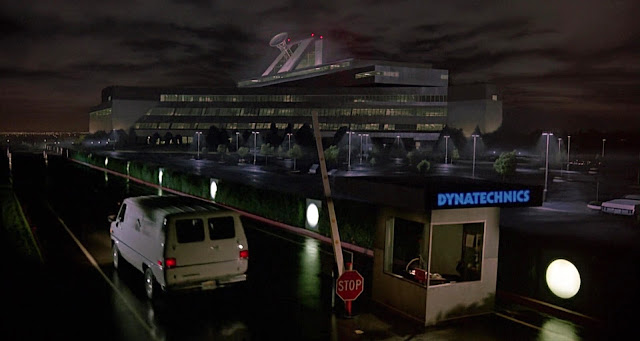 |
| A Frank Ordaz matte shot where around 60% of the frame has been painted. Red blinking lights atop the Dynatechnics complex add a nice 'live' touch. This frame is from the BluRay. |
 |
| Same matte as it looked as an original 35mm test frame. |
.jpg) |
| A nice invisible tilt up trick shot by Caroleen Green. |
 |
| Beautifully done, with no clue as to where the join is between real and painted. |
 |
| Caroleen Green's painted intergalactic zapping contraption, and likely the roof of the complex as well. |
 |
| Location action with painted set extensions and clouds. |
 |
| Credit where credit's due... |
------------------------------------------------------------------------------------------------------------------------
 |
| The last of the really good Trek movies, STAR TREK IV (1986) was a whole heap of fun, and in fact, looked like everybody on screen were having a ball. |
 |
| Left, Craig Barron with matte on stand for composite work. Right, Frank Ordaz deep in concentration. |
 |
| Ralph McQuarrie served as conceptual artist on STAR TREK IV, and this was one of his renderings of a proposed - though unused - look for Starfleet HQ in futuristic San Francisco. Great artwork! |
 |
| Before and afters from the final version of Starfleet HQ. I much prefer Ralph's concept above, personally. |
 |
| A wonderful example at left of a basic block-in without any detail work applied yet. Photos like this are so rare to find and are most informative I find. At right Barron and Evans discuss the final painting. |
 |
| The finished composite, almost certainly an original negative comp, with bi-packed spacecraft above. Reportedly, neither Evans nor Barron were happy with the final shot and felt it was poorly designed, too busy and lacked a central area of focus - vital when a shot is only on screen for some two seconds. |
 |
| A shot that many wouldn't notice as being matte art.... See below. |
 |
| A full painting of a San Francisco Bay area some hundreds of years in the future. |
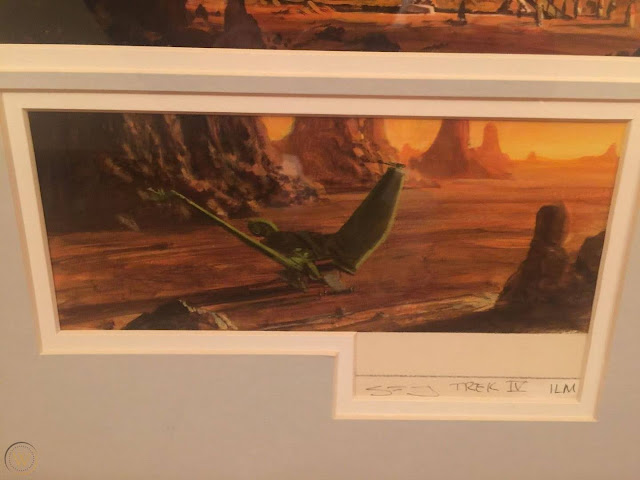 |
| Concept sketch for an important planetary set piece. |
 |
| Frank Ordaz with his pallet rendering the Bird of Prey craft and environs. |
 |
| The final composite, though to this viewer it all looks too 'painterly' and 'stiff' to be fully effective. Just my opinion. |
 |
| Another of Frank's paintings, with additional sunburst element. Possibly a shot recycled from the third TREK picture. |
 |
| The first frame from a massive sweeping pan across the alien landscape as the ship lifts off. A vast painting measuring some 4 x 12 feet in size, and rendered by Sean Joyce. |
 |
| In it's entirety... |
 |
| Spaceship model added as a motion control element, and blue screened in actors as well. |
 |
| Engine flare and interactive 'sunlight' upon ship shot in additional motion control passes with miniature. |
 |
| Brilliant sun was a separate practical element made by directing a light source directly into the lens, with vaseline smeared on a glass as a means of diffusing the light. |
 |
| Not sure, but reckon this is all painted from the waterline upward. |
 |
| The marine park plays an important role in the narrative of TREK IV. Some ingenious trick work was needed here to combine several different locations as one. The marine institute was not actually in San Francisco, and did not have a water tank as seen here. The water was shot elsewhere and matted in. The San Francisco skyline was also a separate live element, filmed hours away, and matted in too. Some subtle matte art was employed to tie all of the different pieces of live action together - and very successfully at that! |
 |
| The same setting as seen later on, this time largely shot 'as is', with the actual empty rock pool. Again, the distant (real) city and sky were actual location 2nd unit plates, though filmed some 80 miles away and combined optically with the marine institute, again with small degree of painted work to marry it all together as utterly convincing. |
 |
| Matte painting supervisor Christopher Evans at work on various conceptual sketches for proposed matte shots. |
 |
| Matte painted park in a misty moonlit setting. |
-------------------------------------------------------------------------------------------------------------------
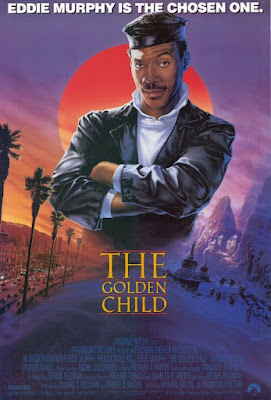 |
| While not as bad as most reviewers might suggest, THE GOLDEN CHILD (1986) was a rollicking mix of comedy, mystery, witchcraft and supernatural shennanigans; chock-filled with top shelf ILM visuals, from matte art, stop motion, cel animated gags, miniatures and a few jaw-on-the-floor major fx set pieces. |
 |
| The opening shot in Tibet was a wonderfully orchestrated mixture of multi-plane matte art by Chris Evans, and intermediate miniatures and optical snowfall. |
 |
| Evans with the deep, multi-plane set up. |
 |
| Craig Barron watches on as Chris Evans touches up the miniature monestary. I assume ILM veteran Paul Huston had a hand in this, with vast experience in miniatures and other gags. |
 |
| For interior shots of the Tibetan monestary, Caroleen Green blocks in not only the architecture but also the majority of the Buddhist priests. |
%20DSC09459.JPG) |
| Green working in the overall structure. |
 |
| The shot was conceived to have a slow push in move, so foreground miniature pillars were built and positioned in front of the painting to lend depth. Chris Evans is pictured here. |
 |
| Final shot with entirely painted monestary, mostly painted people, miniature foreground and a handful of extras in costume filmed on the left side only and then optically flopped to appear on the right side as well, to provide some 'live' movement. |
 |
| Another very quick blink-and-you'd-miss-it matte painted shot was this view as a bird flutters near ceiling. |
 |
| A later visit to the Tibet setting utilises a second establishing matte shot, withb this one being a tilt upward from the live action people. |
-----------------------------------------------------------------------------------------------------------------------
 |
| THE WITCHES OF EASTWICK received a British BAFTA award for Best Special Visual Effects in 1987, and the work was pretty good. |
 |
| Not sure here, may be painted skies or split-screened in real cloud footage? |
 |
| Multiple element shots involving live action, painting, cel animation and possibly cloud tank gags. |
 |
| The classic 'ghostly manor' matte shot, as seen in a hundred old Universal movies. Live action lower plate, painted stately home and sky, plus lightning interactive gags added. |
 |
| From a lousy looking DVD. |
 |
| An invisible matte shot where the house is seen far off in the distance. |
 |
| Craig Barron and Sean Joyce set up a latent image matte shot utilising a large plywood cutout conforming to the outline of the fictional house. The black painted cutout was set up in a chosen position, with the Pacific Ocean in twilight off in the distance. Later, the actual detail of the house was painted at ILM and double exposed into the blacked out sillhouette, with only sufficient detail required for the twilight, backlit conditions. |
 |
| The shot as it appears on screen. A small tilt down was added to what was a thoroughly convincing shot. |
 |
| Artist Sean Joyce working on a sprawling daytime matte painting of the house, though sadly, dropped during the final editing. |
-----------------------------------------------------------------------------------------------------------------------
 |
| A popular kids film, HARRY AND THE HENDERSONS (1987) featured just a couple of mattes in one sequence, though did have a dynamite Rick Baker hairy Yeti suit and amazing articulation which was a character in itself. |
 |
| Oh, and that's Harry. More preferable than Howard the quacking Duck...by a long shot! |
 |
| In one key sequence, Harry stumbles across a busy freeway and kind of 'freaks out'. Matte shot with painted environment and much traffic doubled in later. |
 |
| Harry gets closer to the roadside. I suspect this whole scene was a complex vfx set up. The mountains are painted and the constant passing vehicles and trucks all look 'matted in'. Possibly miniature traffic added by blue screen, especially the big 18 wheeler's that roll by. Interesting. |
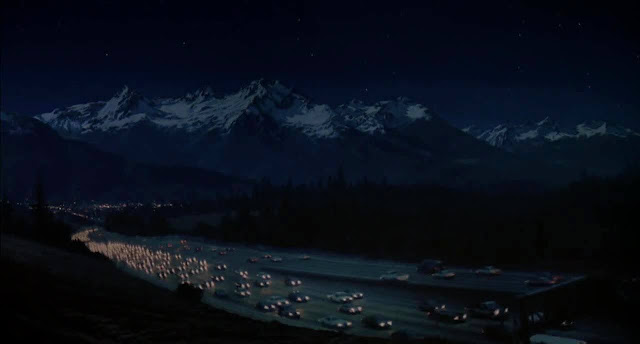 |
| A second view |
-----------------------------------------------------------------------------------------------------------------------
 |
| Definitely a cute little audience pleaser, BATTERIES NOT INCLUDED (1988) was highly enjoyable, and as it featured one of my fave actors from days long gone, Hume Cronyn, what's not to like? |
 |
| I'm fairly sure most or all of these frames are painted mattes. |
 |
| An fx shot, possibly with miniature sign and painted buildings on either side. |
 |
| Caroleen Green was responsible for this tilt up matte shot of the all central old tenement building. The plate was shot 8-perf with a VistaVision camera mounted on it's side, allowing a large negative area once the painting was added and an optical scan included. |
 |
| Same shot, as the partial facade is extended with invisible brush work. |
 |
| The film concludes with a wonderful reveal, as the tiny tenement building is sandwiched between a myriad of highrise skyscrapers - all a major matte shot. |
 |
| Christopher Evans at work on the matte for the above shot, also filmed with a sideway oriented VistaVision camera to facilitate the extreme tilt and very slight optical zoom. |
 |
| Frame by frame as it appears on screen. Virtually all painted, right down to just above the real crowds in the actual plaza. Evans also added a slot gag to his painted fountain, with faux water spraying upward. |
--------------------------------------------------------------------------------------------------------------------
 |
| A massive effects film, WILLOW (1988) was nominated for the VFX Oscar that year. |
 |
| Great kiddie fantasy, jammed with terrific visuals and marvellous matte artistry. I did extensive coverage of WILLOW a few years ago in a massive article, and that may be read here. |
-----------------------------------------------------------------------------------------------------------------------
 |
| A fair entry in the series, but not a patch on the first two films, INDIANA JONES AND THE LAST CRUSADE (1989) had one or two great action set pieces and in at least one instance, truly ingenious effects work by ILM, as well as a fresh stable of matte exponents. |
 |
| Some of ILM's matte department veterans such as Barron and Pangrazio had departed the 'corporate' Lucasfilm world and established another firm of their own, Matte World, which in itself proved highly successful. A new, though highly experienced matte painter had joined ILM around this time, the multi-talented Mark Sullivan. Following many student fx projects and a stint with David Stipes, Mark professionally entered the fx industry primarily as Jim Danforth's protoge at Jim's Effects Associates. The above shot was the work of Mark. Some years ago I conducted a deep delve career interview with Mark: "Around the fall of 1988 I got a call from Scott Ross, ILM's general manager. Except for some of the camera people, pretty much the entire matte department personnel had departed ILM that summer, for various reasons. ILM had INDIANA JONES AND THE LAST CRUSADE, GHOSTBUSTERS 2 and THE ABYSS all in house, and all of those projects had various matte painting shots in need of completion before Memorial Day weekend of 1989. This shot was almost an entire painting, with the lower quarter or so of the car approaching being live action. This was my first matte painting at ILM. I started on it around the beginning of November 1988. This was the glass painting that I cracked, but Paul Huston helped me to repair." |
 |
| Another fresh young matte artist also joined ILM around this time, Yusei Uesugi, whom matte artist Rocco Gioffre - Sullivan's fx business partner - had met at a film festival in Japan in 1985. According to Mark: "Yusei was a student at the time and approached Rocco with some examples of his matte painting experiments. Yusei started at ILM around late January of 1989, as I recall, and we were quite fortunate to have Caroleen Green join us for several months." The above shot is one of Yusei's mattes. |
 |
| Two of Mark's conceptual paintings for important matte shots. |
 |
| Mark's superbly realised matte painted establishing shot for the Republic of Hatay. Magnificent sense of backlight and sweltering 'humidity'. Very 'Whitlock'. |
 |
| Matte in final stages of preparation (see below for final). Mark described the set up at ILM for me: "Early on, for about 4 to 6 weeks, I was the only painter in the matte department. I suggested to the powers that be that they consider hiring Yusei Uesugi, who had done some nice work assisting both Rocco Gioffre and me at our shared studio space in West L.A the previous year. Wade Childress, Bob Hill, Jo Carson and the multi-talented Harry Walton were our main camera people on projects at that time. We could bring in help from other departments as needed: model builders for reference miniatures, grips and electricians for special rigging set ups, and of course the optical department to create RGB separations, registered colour prints or projection plates." |
 |
| The flawless finished composite. |
 |
| Further INDY matte work above by Mark. When asked about the actual working environment, Mark told me: "In terms of the physical infrastructure, there was a very pleasant second story painting studio area, with skylights over each easel. The paintings would be lowered to the first story photography stage down a little dumbwaiter elevator system. The matte photography stage had a small, light-tight film changing room, for loading and unloading camera magazines, and a set of rewinds for breaking down latent image rolls. There were 4 permanent camera set ups with matte stands; one was a versatile system with both the camera, two painting supports and a process projector, mounted to a motion control rig. There was a front projection matte stand that we never used, and two fixed matte stands, constructed from box steel for locked-off shots. One was a Bell & Howell 2709 four-perf camera, mounted to a steel pedestal, and the other, with a Vista-Vision eight-perf camera, was also mounted on a steel pedestal. All the stands or pedestals were bolted to the floor, which I believe, was poured concrete under the linoleum." |
 |
| The action heats up in this closer cut. |
 |
| A cleverly concieved trick shot which Mark called The Crescent of the Moon shot. See below... |
 |
| Mark described this trick shot clearly: "This photo, taken off-axis from the movie camera's line up, shows Paul Huston's miniature terrain behind my panel painting of the surrounding mountains and sky. Paul devised a very clever technique to trim the bottom of the painting down to a knife edge, so it would blend better with the background. Paul also handled the very difficult colour blending of the background miniature - the painting was created first, and the miniature was built to match". |
 |
| Yusei at work on elements for the dramatic 'Leap of Faith' sequence which ultimately involved physical props, miniatures, matte art and painted backings - to amazing effect. |
 |
| Mark had much praise for miniatures collaborator Paul Huston: "Paul was another huge talent who seemed to enjoy working with the matte department. We were able to save some time on certain shots by using some of Paul's beautiful miniature work, in lieu of painting everything in the frame. For instance, several of the shots in INDY's 'leap of faith' sequence were entirely Paul's work. Paul carved and shaped the steep cliff walls, and modelled and painted the trompe l'oeil piece that Indiana Jones steps onto in that sequence." |
------------------------------------------------------------------------------------------------------------------------
 |
| An amusing sequel to the hit '84 blockbuster, GHOSTBUSTERS 2 (1989) was a huge effects assignment. I never saw the new revisionist girly re-boot, though by all accounts, it stunk! |
 |
| For the abandoned NYC subway station, a minimal set was built and extended considerably with matte painting and a miniature river of 'slime'. |
 |
| A second cut from the same scene, with multiple components. |
 |
| Not sure if this was a full matte painted New York (probably) or retouched photo blow up, with the lights all going out, as there's something strange goin' on. |
 |
| This shot was definitely a full matte painting. |
 |
| An astonishingly breathtaking full matte painting by matte supervisor Mark Sullivan. |
 |
| Mark with his masterpiece. Sad to say matte fans, this beautiful piece shattered to a thousand pieces sometime later. I tentatively brought the topic up with Mark: "Yes...at some point when it was being hung up to display, it was dropped and it shattered! I don't know if it was salvageable as I wasn't there at the time. That's the sad and dangerous thing about using glass. I would use a heat lamp to dry the oil painted glass mattes overnight. Once I stupidly aimed the heat lamp at only one end of a painting, where I'd been painting, and by the next morning, the temperature difference between the ends had cracked the glass." |
.jpg) |
| Here is a wonderful test frame of Mark's as yet unfinished matte, though around 80 to 90% of it has been completed. |
.jpg) |
| Close up detail showing Mark's perspective lines drawn in, and sketchy motor vehicles parked. |
.jpg) |
| More detail where highly finished brush work is juxtaposed with loose blocked in forms. |
 |
| The finished shot as it appears on screen in 2.35:1 theatrical. Love Mark's perspective, and probably regard it as his best matte, and I have had the privilege of seeing pretty much all of his archive. |
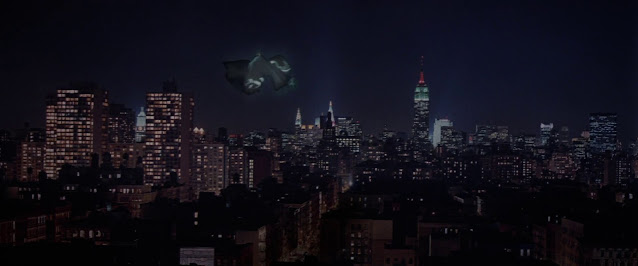 |
| Another painted wide vista of Manhattan, with evil baby-thieving ghost nanny doubled in. |
 |
| I'm not sure here - certainly a lot of vfx going on. Possibly painted city? |
 |
| The museum at the centre of the shot was a large miniature, with some live action and a great deal of Mark's matte art for the remainder of the view. An original negative comp, on VistaVision. |
 |
| Again, miniature museum with matte painted skyscrapers and live action extras. |
 |
| More of the same... |
.JPG) |
| Matte cameraman Wade Childress takes a light reading from the large miniature of the Liberty Lady, as Mark paints the lower portion of the statue on glass, where rear projected characters will be added in what would become a very dramatic downview as 'she' comes to life! |
 |
| Final shot. |
 |
| Stunt guy in a Liberty Lady suit in a tank, shot against bluescreen. Not sure if the city is matte painted but feel it was likely as a night shot was better suited to matte art. |
 |
| A monumental number of effects cuts were needed for the whole sequence, with some shots being live street crowds requiring painstaking roto work to include action as giant lady strides down Fifth Avenue. Some shots used miniatures and some, such as this (I'm certain) were sprawling matte paintings, rendered largely by Caroleen Green. Sullivan commented that to achieve a decent exposure when attempting to shoot live in New York on a busy night would have been difficult in itself, so matte painting was seen as a safer alternative. Fabulous shot! |
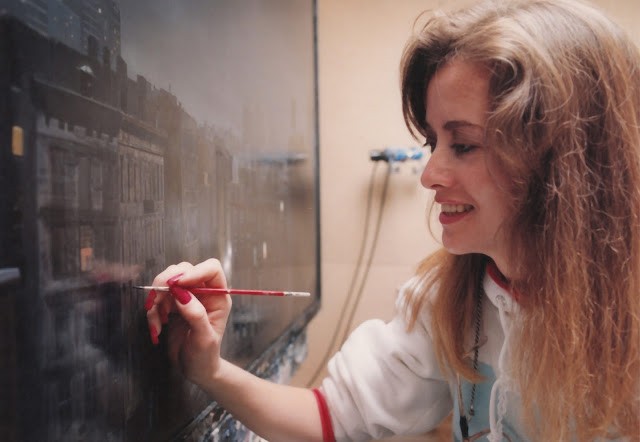 |
| The always photogenic and highly talented Caroleen Green armed with brush, finalises detail work upon her wonderful Fifth Avenue matte. |
 |
| Pretty sure this view was also mostly painted, with what appears to be a matte split running along just above the first floor of the actual 'live action' buildings. |
----------------------------------------------------------------------------------------------------------------------
 |
| THE ABYSS (1989) was a visually stunning experience for sure, though marred by appalling dialogue and stock, two dimensional, cardboard cut-out performances. A director who can only handle spectacle like few others and has not a clue when it comes to character development. Sad to say it, but that glow-in-the-dark translucent entity from the ocean floor gave the best performance. |
 |
| The show was loaded with well deserved Oscar winning visual effects from a number of suppliers. Just the one solo matte shot as far as I am aware, with this 35mm wedge test being a Mark Sullivan shot: "The matte painting process really involves an enormous amount of communication and joint thinking between the matte artist and the matte camera person. For instance, I worked with Harry Walton on a pretty challenging matte shot for THE ABYSS - a movie that Dennis Muren was supervising. A portion of the shot was an original negative plate, another portion was a rear projected element, behind the glass painting, of a large, live action wave, and there was a foreground element of some sailors that was an in-camera travelling matte. Optical had prepared a black and white hold-out matte that Harry would bi-pack when he was shooting the painting, with the projected water footage, onto the latent image roll. Harry would then have to load up the latent onto his optical printer, and expose in the positive RGB separations onto the take. With all of the colours and densities that had to be matched and balanced for all of the elements, it was a lot to keep track of". |
----------------------------------------------------------------------------------------------------------------------
 |
| An odd little 'romantic comedy' seemed almost a throwback to the screwball comedies of the thirties, JOE VERSUS THE VOLCANO (1990) featured matte art, travelling mattes and miniatures. |
 |
| The flick opens with this tilt up onto a quite deliberately skewed cityscape, with Yusei Uesugi as matte artist and Jo Carson shooting the mattes. |
 |
| Lovers lane with all the glittering lights. Not sure about lower shot, but certainly appears to be a vfx view, due to the bizarre colour scheme. |
 |
| Tom Hanks on his voyage to find himself. Miniatures, matte art and optical gags. |
 |
| A highly romanticised bit of corny storytelling. |
 |
| Mysterious South Seas paradise? ... Nah, it just a matte shot. |
 |
| May be miniatures, or partial painted combinations? |
------------------------------------------------------------------------------------------------------------------------
 |
| John McClane kicks arse in Chicago this time for DIE HARD 2 (1990). A good, solid, ruthless, no bullshit action flick, though not quite as good as the original, was a far sight better than those which followed (*footnote: I was present with family on vacation in Budapest in 2012 and spent the day watching the filming of action sequences for part 5 of the series, with Budapest standing in for that bastard Voldemort Putin's Moscow) |
.jpg) |
| Lots of explosions and A-grade model shots, though only the one, impressive matte shot, which comes at the end in a massive pullout (I do mean massive!!) Here, artist Yusei Uesugi is working on the preliminary stages of the vast airport painting, with a number of airliners and emergency folk convene. |
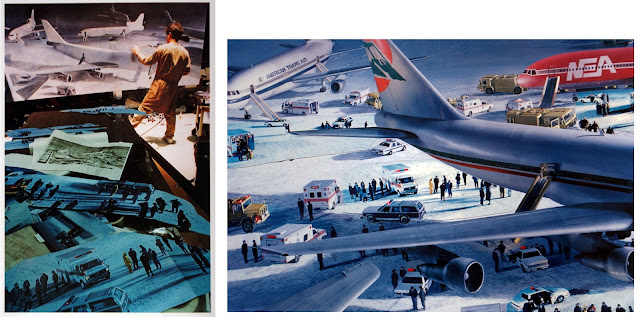 |
| All of the airlines on screen were fictional companies, no doubt due to the fact that several of them are blown to bits, mid-air! |
 |
| Close up showing painted detail and photo blow up area pasted in for scale and lighting reference. |
 |
| Yusei's mural sized matte on the wall at ILM years later. |
 |
| The shot was composited using very primitive computer technology of the day and transferred back onto 35mm film in what was a massive and time consuming process involving, if I recall, maybe a crate load of floppy disks and a main frame to contain the data. |
-----------------------------------------------------------------------------------------------------------------------
 |
| The frequently beautiful DREAMS (1990) from esteemed Japanese film maker Akira Kurosawa literally did have a dream-like quality to it. |
 |
| Among the few mattes was this gorgeous rendering by Mark Sullivan. |
 |
| Mark's painting on the wall at ILM. |
 |
| Another ILM matte shot by Caroleen Green. |
NON-ILM MATTE SHOTS:
 |
| I believe these shots were made in Japan, at Den Films, by matte artist Taksuhiro Miyaguchi. |
-------------------------------------------------------------------------------------------------------------------
 |
| Oliver Stone has been somewhat of a hit or miss film maker over the years, though I'd have to say he's been more on the 'hit' side than the other. THE DOORS (1991) was excellent! No two ways about it. A brilliant bio-pic on Jim Morrison and the band, with astonishing performances, especially by Val Kilmer, who really never did anything as good ever, before or since. Fab soundtrack too...naturally! |
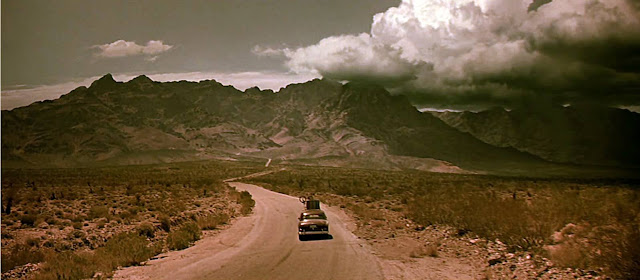 |
| Just a few visuals in the film, including a pair of Mark Sullivan matte paintings, with this one starting off the show as a seemingly genuine locale. |
.jpg) |
| Mark's splendid painting, sans live action. |
 |
| Closer view of the painting. |
.jpg) |
| A second matte in the same sequence - with a painted desert and stormy sky as seen through an approaching car windscreen - was one that Mark told me he found particularly satisfying. The original plate was shot hand-held from the back seat of a car on a bumpy desert road. Mark's painting was later match-moved on the Auto-Matte camera with much care, making this ILM's first match-move, motion-control matte composite. |
 |
| While the upper frame is from the BluRay edition, this one is from Mark's original 35mm wedge test. |
-------------------------------------------------------------------------------------------------------------------
 |
| Ron Howard's 1991 firefighter movie, BACKDRAFT had plenty of pyro and episodes of frightening conflagration, as one would expect. One matte painted shot was supplied by ILM for a key sequence. |
 |
| For a sequence involving a burning warehouse with people on the roof the wide shot was achieved with a cleverly combined matte painting, by Mark Sullivan, which was composited with a large burning miniature roof and upper floor. An actor was later added in, running across the inferno's roof. |
 |
| ILM's miniatures people built this rooftop. |
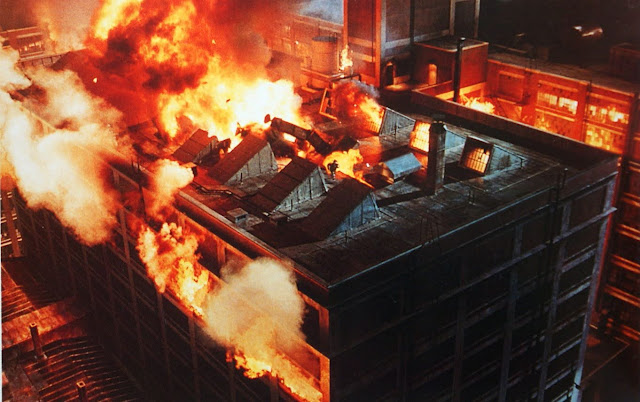 |
| The final shot, with all of the elements tied together so well (note the small figure running toward edge of roof). |
 |
| And this was how it looked once cropped down in the Super-35 release prints. |
--------------------------------------------------------------------------------------------------------------------
 |
| Yep... I thoroughly enjoyed this movie. THE ROCKETEER (1991) hit all the targets for me. Great 1930's Saturday matinee serial vibe, fab art direction, engaging performances, terrific effects work, a dastardly villain, an amazing Rondo Hatton-esque thug, and the exquisite Jennifer Connelly, who never looked more radiant! |
 |
| Once again, Mark Sullivan was matte painter, and rendered a handful of wonderful period shots such as this one of Hollywood Blvd. Incidentally, the director, Joe Johnston started off as ILM's visual effects art director way back on the first (and best) STAR WARS. |
.jpg) |
| For a major action set piece where The Rocketeer blasts off from a nightclub, up through the atrium and over Hollywood, Mark Sullivan painted this massive aerial view of the entire district. Mark initially rendered a small painting of the view in order to aid the stop motion animators with perspective etc as they animated the puppet Rocketeer. Sullivan then commenced prep work on what would become a massive painting on a sheet of Lexan, measuring some 19 feet wide x 6 feet high. |
 |
| In the past, several other ILM matte exponents had utilised the helpful aid of photographing very rudimentary models prior to commencing on a complex matte perspective piece. Pangrazio did it for his closing RAIDERS shot and others did on occasion as well. Mark Sullivan elaborated: "The birdeye's view of Hollywood, and the South Seas Club presented some challenging perspective work. The ILM model shop made a few hundred tiny wooden blocks for me, and I arranged them in a grid, following the linoleum tile edges of the floor of the matte painting work area. I traced out the reference photos onto an ink and pencil layout painting, about 20 inches wide. This layout art was then photographed, projected and drawn onto the large matte painting surface. Having the perspective laid out saved a lot of time, and kept the guesswork to a minimum when I was painting." |
%20DSC09453.JPG) |
| Mark did a fair amount of research into 'old Hollywood' and established which landmarks still existed and those long since demolished. |
.jpg) |
| A close up image from Mark's incredible painting. The brightly illuminated dome upper centre, next to the Egyptian cinema, was the start point for the Rocketeer to blast skyward in the final scene. |
.jpg) |
| Another close up. The shot was filmed as one continuous camera move but director Joe Johnston decided break the shot to make the action in two cuts. |
 |
| Sullivan also painted this later seen vista of LA with the Griffith Observatory and spotlights. |
 |
| I feel it would be sadly remiss of your humble blogger to not insert this subtle, passing glimpse of the exquisite Jennifer Connelly - who never looked more fetching than in this flick. |
-----------------------------------------------------------------------------------------------------------------------
 |
| Steven Spielberg's HOOK (1991) was, sadly, a complete misfire. An astonishingly dull attempt at a timeless children's fairy tale, where in truth, really should not have missed the mark so badly. That said, ILM's matte department really came to the party with superb matte work and some neat trick shots. |
 |
| A number of matte artists worked on this film. Oddly, this matte, seen here on display, was in fact a large colour photo blow-up - licensed from a stock image agency - retouched by ILM fx art director Dave Carson and matte artist Yusei Uesugi, mainly to add snow to the rooftops and the bridge. I'd always figured this to be a marvellous full matte painting but Mark spilled the beans for me and I never forgave him! |
.jpg) |
| The shot as it appears in the film, with nice cel animated sparkles over the heads of a pair of cute in-joke personalities - a certain George Lucas and Carrie Fisher, or so I'm told! |
%20028.jpg) |
| Mark Sullivan was, once again, supervising matte painter on HOOK, with this being one of Mark's conceptual paintings to establish the look of the island. |
 |
| In my interview with Mark, he described this interesting out take: "This is a test frame of three separate back projection elements being feathered into the as yet incomplete matte painting. This was eventually used as part of an optical comp, to place Robin Williams into the foreground. A lot of the colour and clarity of the painting, and it's rear projected portions, were lost in the final optical composite". |
.jpg) |
| The final matte composite, minus the live action element of Williams. |
DSC09549.JPG) |
| Probably my favourite among the many HOOK paintings was the absolutely captivating kids Neverland tree clubhouse setting. |
 |
| Sullivan's full painting as it appears in the film, with live action kids on the right side of the ledge. |
.JPG) |
| This would look so nice on my wall at home - if I didn't have a half dozen other mattes already up there! |
 |
| close up |
 |
| Although Chris Evans had departed ILM by this time, he did return for a while to assist with the 20 odd HOOK mattes. |
.jpg) |
| Evans' painting on the LucasFilm wall. Magnificent subtlety with the hues here. LOVE IT! |
 |
| Close up detail... |
 |
| Final composite with actors dropped in via blue screened TM. Many of the mattes for HOOK contained multiple elements and gags, worked into the shot, with in some cases as many as 30 separate elements, ranging from breakers, water sparkles to waterfalls to interactive firelit torches and so on. |
 |
| Another of Mark's shots: "Everything is painted here, except the water, which has been added as a bi-pack element. The moons were separate paintings, shot on separate passes, so they could be rising at different speeds. The moons were shot through a split, so they could be seen behind the horizon". |
 |
| Not sure about this, it almost has a miniature quality about it, but is probably painted? |
 |
| Most of the HOOK mattes linger on screen for a longer time than would be usual for painted shots. This shot is one of Yusei Uesugi's painted mattes. The actual sunset sky was real, photographed by a second unit with a sillhouette painted black on a sheet of glass to create the exact outline of the land mass set up in front of the camera, and combined later in with Yusei's painting and other atmospheric elements. |
 |
| Sullivan started work on HOOK right as far back as it's initial pre-production phase, working closely with Spielberg and the fx chief, art director and others to properly establish the desired look and feel for the twenty plus matte shots. |
 |
| Mark described his style: "I wasn't a meticulous 'fill in the drawing' type of painter. I once had an instructor who would say 'Draw with the paint'. I would usually start laying in areas with a large brush, and then work down to the smaller brushes as various areas were refined. If an area or effect from the initial rough-in seemed to work, I would then leave it alone, or at least try to preserve what it had to offer." |
 |
| The actual painting rendered for the above scene. |
.jpg) |
| A highly complex tilt-upward shot involving a large 20 foot high miniature tree, various live action plates of rocks, ocean and crashing waves, stop-motion flat cutouts of birds, plus matte painted areas and a large painted backing. |
 |
| HOOK recieved an Academy Award nomination for best visual effects, and I recall seeing the shot where Peter glides through the clouds over Neverland as being shown on the Oscar broadcast that night. Here Yusei attends to a spectacular painting for that very sequence. |
 |
| Multi-element effects shot with Williams on a flying rig in front of a massive blue screen; artificial clouds, and Yusei's expansive matte art of Neverland. |
 |
| Yusei's traditional 2D painting was scanned into the computer and an early texture mapping tool was used to allow for some perspective shifts as the motion shot went along. Some other subtle elements were also added such as shadows and softening of the practical stage produced and photographed clouds. |

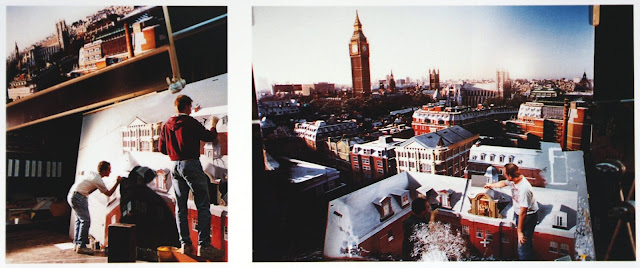 |
| The final big effects shot in HOOK was back in period London, where an enormous camera pull-back was desired, from the characters on a balcony, out and upward across London. An ingenious trick, though one used since the 1920's - with the old Warner Bros. Stage 5 effects department being trophy holders for doing just such fx shots on countless classic films. At left we see matte painters Rocco Gioffre and Eric Chauvin at work on a large 10 foot wide foreground matte painting - one of two - of the house frontage and nearby buildings. Suspended above it is a second large 8 foot wide photo blow up of the London skyline, which itself has been considerably reworked with paint to omit modern buildings and alter period structures so as to bring a more romanticized feel to the city. Yusei also worked on these paintings. |
 |
| FX cinematographer lines up the two paintings, with the lower, foreground one having rear projected people added onto the balcony. |
 |
| The big reveal, as the camera zooms out and swings upward, just how Warner's used to do it so well for so many pictures throughout the thirties and forties, on shows like THE FOUNTAINHEAD, THE ADVENTURES OF MARK TWAIN and THE HORN BLOWS AT MIDNIGHT - all of which NZPete has covered in depth in past blogs. Seek 'em out...you don't know what you're missing! |
 |
| Frame from the sequence where the RP people can be seen on a matte painted balcony. |
 |
| The finale. Rocco Gioffre mostly was responsible for this heavily retouched photo-matte. Certain artistic changes were demanded by the director such as to re-paint Big Ben in closer to the action, for more recognisable value, as it was too far away in the original, actual photographed view. |
----------------------------------------------------------------------------------------------------------------------
 |
| Here's a fairly entertaining sort of show, MEMOIRS OF AN INVISIBLE MAN (1992), though I much prefer my 'invisibility' flicks of the old Universal-John P. Fulton variety, personally. |
.jpg) |
| A few matte shots, though some may have been of the 'digital variety', which we try not to discuss here. This one though is a real, with the actual artwork shown below being a genuine matte painting, rendered by Christopher Evans |
 |
| Chris' original matte painting. |
 |
| Not certain here, but these have a profoundly 'manufactured' computer look to them (I might be wrong). |
NON-ILM MATTE EFFECTS SHOTS:
 |
| As with certain other ILM shows, such as THE EWOK ADVENTURE and NEVER ENDING STORY, veteran matte and all round trick shot expert Jim Danforth was hired to provide some mattes. Here is an informative before and after for one of Jim's shots which nobody would ever suspect as being a matte painting. |
.jpg) |
| BluRay frame of Jim's matte, though, who would know? |
 |
| Jim also painted this snowbound mountain cabin retreat for a later scene in the film. |
 |
| The final composite, with this frame enlarged from one of Jim's original 35mm wedge tests. |
.jpg) |
| ...and, as it appears in the BluRay edition. |
---------------------------------------------------------------------------------------------------------------------
 |
| A rather strange film, DEATH BECOMES HER (1992), which I think may have been nominated for an FX Oscar?? Memory failing in my old age, and no, not from Long Covid... didn't get it! |
.jpg) |
| Amid the numerous optical and CG gags was this solo traditional matte painted shot by Mark Sullivan. This was one of the last traditional mattes Mark painted for ILM, as he regaled the story to me in 2013: "I well remember having a nervous laugh about it [traditional mattes] with Ken Ralston. Most of the ILM matte guys were by then working on computers in a darkened room elsewhere in the building, to see the monitors better. I was working upstairs alone in the essentially abandoned ILM matte painting area, and Ken came up to look at a wedge test on the lightbox. The place was starting to get dusty and unkept, and I guess we could both clearly see the shape of things to come". |
----------------------------------------------------------------------------------------------------------------------
 |
| I've never seen this film, THE PUBLIC EYE (1992) is one I must catch up with. |
 |
| This invisible shot from THE PUBLIC EYE is another Mark Sullivan matte: "The matte painted work is all of the background buildings, above, and to the left of the green Oldenburg truck. The grey concrete building in the centre of the frame is all real, except for it's 'sunny' side on the right, above the two story building. The upper story of the closest building on the right side of the frame is painted. The real bricks are just a bit lighter looking compared to my painted ones. This was an ILM project, done right after HOOK". |
------------------------------------------------------------------------------------------------------------------
 |
| Wow...who'd have thunk it? A traditional matte in the non-traditional epic box-office bonanza, JURASSIC PARK (1993)?? Well, yes indeed! |
.jpg) |
| And there, my friends, you have it! A magnificent Christopher Evans traditional painting for JURASSIC PARK. |
 |
| Truly great art but sadly muddied up to near oblivion in the final washed out digital composite. |
---------------------------------------------------------------------------------------------------------------------
 |
| I'm of a mixed mind about Coen brothers films - some are brilliant (NO COUNTRY FOR OLD MEN and OH BROTHER, WHERE ARE'T THOU and FARGO) while others leave me utterly perplexed, such as THE HUDSUCKER PROXY (1994) |
 |
| I was of two minds as to whether to include this film. It was an ILM affair, but, importantly, the matte painted shots were rendered independently outside of Industrial Light & Magic. Mark Sullivan was, by now, working largely on his own as a freelancer from his small studio in Berkeley, California, and provided a few mattes as a sub-contractor. |
.jpg) |
| Sullivan in his independent matte shop, where he painted for a number of big assignments. |
 |
| Before and after for the big HUDSUCKER reveal. |
 |
| A staggering piece of work in anyone's book! I'd go completely cross-eyed after an hour attempting such a complex painting!! |
 |
| The finished, incredible original negative matte shot, as seen here in a rare full frame 35mm trim from Mark's archive. |
 |
| Closer look... |
----------------------------------------------------------------------------------------------------------------------
***This post, and all 175 previous blogposts known as 'Matte Shot', were originally created by Peter Cook for nzpetesmatteshot, with all content, layout and text originally published at http://nzpetesmatteshot.blogspot.com/
------------------------------------------------------------------------------------------------------------------------
Hope this was an enjoyable ride... do drop me a note if you liked it, or have any comments
Pete








.JPG)







































.jpg)







_3803.jpg)




_6192.jpg)
_6123.jpg)
_6036.jpg)









.jpg)


























%20DSC09459.JPG)


































.jpg)
.jpg)
.jpg)

























.jpg)






%20DSC09453.JPG)
.jpg)
.jpg)


.jpg)
%20028.jpg)
.jpg)
DSC09549.JPG)

.JPG)


.jpg)









.jpg)


.jpg)



.jpg)

.jpg)




.jpg)






.JPG)





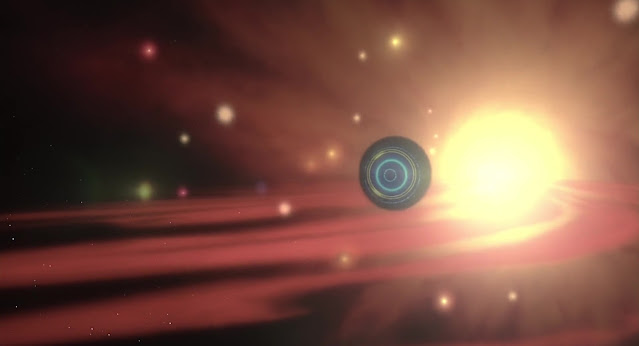

















_2739.jpg)


.jpg)




























.JPG)






.jpg)




.jpg)



.jpg)









.jpg)






.jpg)

.jpg)



.jpg)

Brilliant! As usual!!
ReplyDeleteI needed my NZPetes fix. Whew, just in time. I applaud your time, appreciation and work that you put into your site. Spectacular!
ReplyDeleteI do appreciate your feedback and obvious enjoyment of this work.
DeletePete
Oh yeah! I've been patiently waiting for the second part. Thank you Pete.
ReplyDeleteanother totally amazing entry...loud applause as usual,Pete
ReplyDeletegreetings from Amsterdam
William
Hi William... Thanks, my most dedicated Hollander matte friend.
DeletePete
youre very welcome...
DeleteExcellent as always Pete. The Hudsucker warehouse has always boggled my mind too.
ReplyDeleteCrackin' blog as always, Pete! I never fail to learn when I read your work, and I must say, I don't know if digital matte paintings have ever really matched the magic of traditional ones. Oh, and Death Becomes Her was indeed nominated for, and won, the Oscar for Best VFX (shared with Amalgamated Dynamics)! I think it was up against Batman Returns and Alien 3.
ReplyDeleteThanks for that confirmation on the Oscar.
ReplyDeletePete
Just a treasure trove of beautiful work by these masters. Thank you for showing us all of these from a legendary moment in time of cinematic history.
ReplyDeleteHi David,
DeleteIt's all just so much more fascinating than the sterile, photoshop type methods used nowadays, don't you agree?
Besides, these 'true' mattes are tangible pieces of physical 'art' - real paint, structured and applied upon a rigid surface... art that can be hung on the wall and appreciated. You can't hang a digital matte painting on the wall... just a print-out, and that's not terribly interesting.
Pete
Hello Pete, FYI you have a photo of cameraman, Randy Jonson, early on where he is un named. Also, there is a photo of Craig Barron and Randy Jonson setting up a latent shot, which mistakenly says that it is Sean Joyce.
ReplyDeleteThanks for the clarification. I wasn't aware of the identity in the COCOON set up, and the later EASTWICK pic just looked like Sean.
DeleteIt's always too tricky to try and go back in and 'amend' these mammoth blog posts, with some disasters in the past when trying to re-save, resulting in material getting lost!
Peter
Wow, what an amazing post. Thanks for sharing!
ReplyDeleteHopefully everyone's aware that Disney + offers a fantastic 6 part series about ILM. Matte painting is discussed and Harrison Ellenshaw is featured quite often. The first 2-3 episodes focus on ILM through their "analog" period while the other episodes discuss the transition phase to digital. It's incredibly well done, easy enough for the layman to understand but featuring a ton of behind the scenes footage as well.
ReplyDelete"I feel it would be sadly remiss of your humble blogger to not insert this subtle, passing glimpse of the exquisite Jennifer Connelly - who never looked more fetching than in this flick."
ReplyDeleteAlways two VERY good reasons to watch a Jennifer Connelly movie!
Ditto, and Double Ditto!!
DeletePete
Excellent retrospective on ILM. It's amazing how quickly ILM switched from traditional matte painting to digital matte painting in the 1990s. Quicker than most other effects studios according to your other blogs. It's also amazing how their last traditional matte painting, which was for Jurassic Park, got pretty much replaced by a digital version. Having read Cinefex magazine, it seems that ILM permanently switched to digital matte painting after that film i.e. Maverick, The Mask, Forrest Gump, Baby's Day Out, etc., etc., and so forth.
ReplyDeleteThanks for those generous words. Luckily I had some good conversations in the past with Mark Sullivan, who was probably ILM's last ever traditional artist, where he explained a great deal.
DeletePete
You're welcome. For the record, The Young Indiana Jones Chronicles was the first time that ILM created matte paintings entirely by computer. This has been confirmed by numerous sources, including Cinefex. Given the lower resolution of network television at the time, you could say that the show was a test to see if ILM's matte department should permanently switch to digital.
DeleteYes, I well recall the coverage in Cinefex, and later in the second big ILM coffee table books. Still, as a (very) conservative 'old school' fan such as myself, there's nothing as exciting as the traditional 'oils & brushes' means of generating sheer wonder or for that matter, subtle 'invisible' trickery on good ole' glass.
DeletePete
That bit about Mark Sullivan working on a matte painting for Death Becomes Her in a near empty room at ILM is interesting. This was back in 1992 when the film was in post-production. It pretty much establishes that ILM was the first VFX studio to permanently switch from traditional matte painting to the digital kind. As mentioned in your blog and in Cinefex, other VFX studios such as Illusion Arts, Matte World Digital, and a few British companies held on to the old style of matte painting up till the late 1990s.
ReplyDeleteDear 'anonymous'
DeleteAs Mark so succinctly put it: "I could see the writing was on the wall", as he observed little darkened cubicles springing up around the place.
Pete
The optical printer operators and rotoscope animation department came next. The Meteor Man was pretty much ILM's last film to feature a significant number of optical composites and traditional effects animation. A similar thing happened with Buena Vista Visual Effects on Hocus Pocus.
Delete